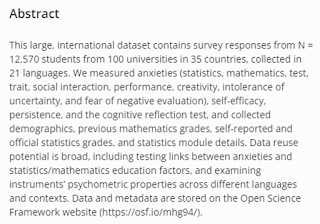You all. Many people, but mostly Jenny Terry and Andy Fields, but also a number of my Twitter mutuals, collected a crap ton of data from statistics students worldwide.
See:
 |
Here is the article describing the project. The data is embargoed until October 2024, but you can contact the corresponding authors if you would like early access. Also, they have tons and tons of documentation available at OSF. So you can come up with your own hypotheses and test them. Which is very, very generous.

Comments
Post a Comment